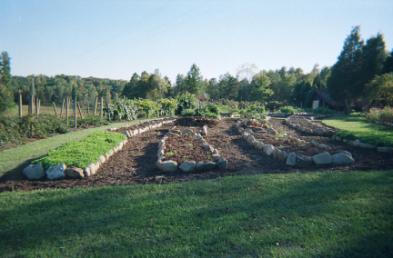Why We Use Raised Beds
|
|
After long deliberation, we made a decision to establish permanent raised beds t cultivate crops at Abanitu. We used large river rock for the edging, which is permanent, non-polluting, a heat sink in cold weather, and an energetic 'bass line' for harmony in the gardens. It is also visually appealing, and makes a nice seat on occasion. Our raised beds are 4-5 feet wide and vary in length from 8 feet to 30 feet long, depending on the site and use in the garden's scheme.
Raised beds have several advantages over conventional row cultivation:
- Heavy clay soil (that's what we have) drains more quickly, allowing for weeding and planting sooner in wet times
- Clay soils can be developed more quickly, with amendments applied directly to the planting areas
- The soil warms up more quickly, allowing for earlier crops
- The soil stays warmer longer, allowing for later crops
- Permanent walkways between beds become automatic soil fertility generators when mulched
- No-till farming becomes realistic
- Closer spacing between crops provide higher yields
- The homes of beneficial insects and small animals are created and protected, encouraging them to stay
- Very accurate records of crop rotations and soil development activities can be maintained
There are disadvantages as well:
- Rocks and other edging can be expensive
- Bed maintenance, if no edging is used
- Beds dry out more quickly in dry seasons, making irrigation necessary
- Weeding is done by hand or with hand tools
- Time required to establish beds
Overall, we are very pleased with the performance of our crops using the permanent raised bed system, and plan to build more as we increase our production capacity and expand the farm's eco-system.
